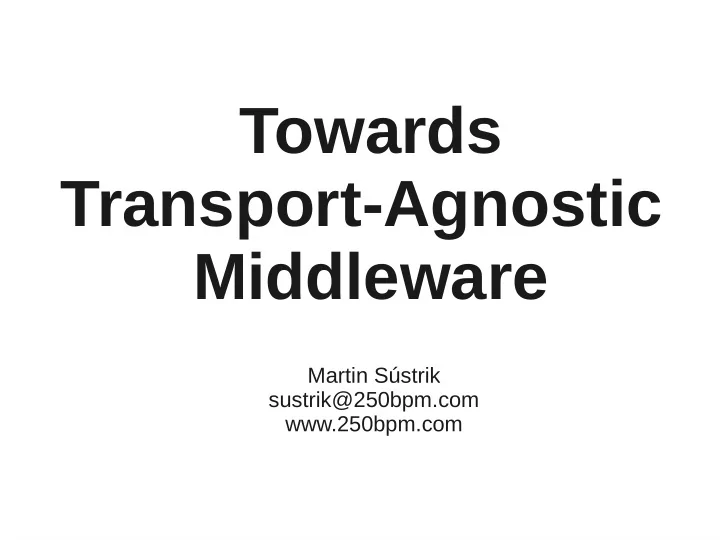

Towards Transport-Agnostic Middleware Martin Sústrik sustrik@250bpm.com www.250bpm.com
Messaging Middleware A layer in the network stack to manage communication between more than two endpoints.
ZeroMQ/nanomsg 1 minute overview
As a layer in the network stack it implements multiple protocols, a.k.a. “messaging patterns”. ● Request/Reply ● Publish/Subscribe ● Pipeline ● Survey ● Et c.
Publish/Subscribe Distributing data to all interested endpoints
Request/Reply Load-balancing tasks among stateless workers
What about the transport layer?
It's heterogenous!
Code example int main() { int s = nn_socket (AF_SP, NN_PUB); nn_bind (s, “tcp://eth0:5555”); Publisher nn_bind (s, “pgm://eth0;241.0.0.1:5555”); while (1) { nn_send (s, “ABC”, 3, 0); sleep (1); } } int main() { int s = nn_socket (AF_SP, NN_SUB); nn_connect (s, “tcp://myserver:5555”); Subscriber while (1) { char buf [100]; nn_recv (s, buf, sizeof (buf), 0); } }
Why should this group care?
Because it's hard for the application developer to make informed decision about transport protocol to use: ● Reliable or unreliable? ● Unicast of multicast? ● Ordered or unordered? ● Pushback or no pushback? ● Widely used (TCP, UDP) or niche (SCTP)? ● Et c.
Often, informed decision can't even be made at the development time: ● Developer has little understanding of customer's deployment environment... ● Application is sold to different customers, each having different network... ● Environment is going to change in the future...
Yet, by choosing a “messaging pattern”, developer provides enough information to make an informed decision about transport protocols to use!
Example Publish/Subcribe pattern requires transport layer not to be reliable. Reliability would mean that a single slow or dead subscriber can stop the entire distribution tree. Preferred transport protocol is UDP or DCCP .
Different example Request/Reply pattern requires transport layer to exercise pushback. That way the tasks can be redirected from overloaded workers to underutilised workers. Preferred transport protocol is TCP or SCTP .
What are the implications?
Back to the heterogenous example:
No need to specify the transport protocol: int main() { int s = nn_socket (AF_SP, NN_PUB); nn_bind (s, “eth0:NYSE-stock-quotes”); Publisher while (1) { nn_send (s, “ABC”, 3, 0); sleep (1); } } int main() { int s = nn_socket (AF_SP, NN_SUB); nn_connect (s, “myserver:NYSE-stock-quotes”); Subscriber while (1) { char buf [100]; nn_recv (s, buf, sizeof (buf), 0); } }
What we get is clean mechanism vs. policy separation!
Developer specifies the mechanism: “NYSE stock quote feed is to use the Publish/Subscribe pattern.” int main() { int s = nn_socket (AF_SP, NN_PUB); nn_bind (s, “eth0:NYSE-stock-quotes”); while (1) { nn_send (s, “ABC”, 3, 0); sleep (1); } } Mechanism is specified via transport-agnostic API.
Administrator specifies the policy: “NYSE stock quote feed is to use PGM on the LAN and TCP over the WAN.” NYSE-stock-quotes: LAN: pgm WAN: tcp Policy is specified via transport-aware network configuration tools.
Questions? Email: sustrik@250bpm.com
Recommend
More recommend